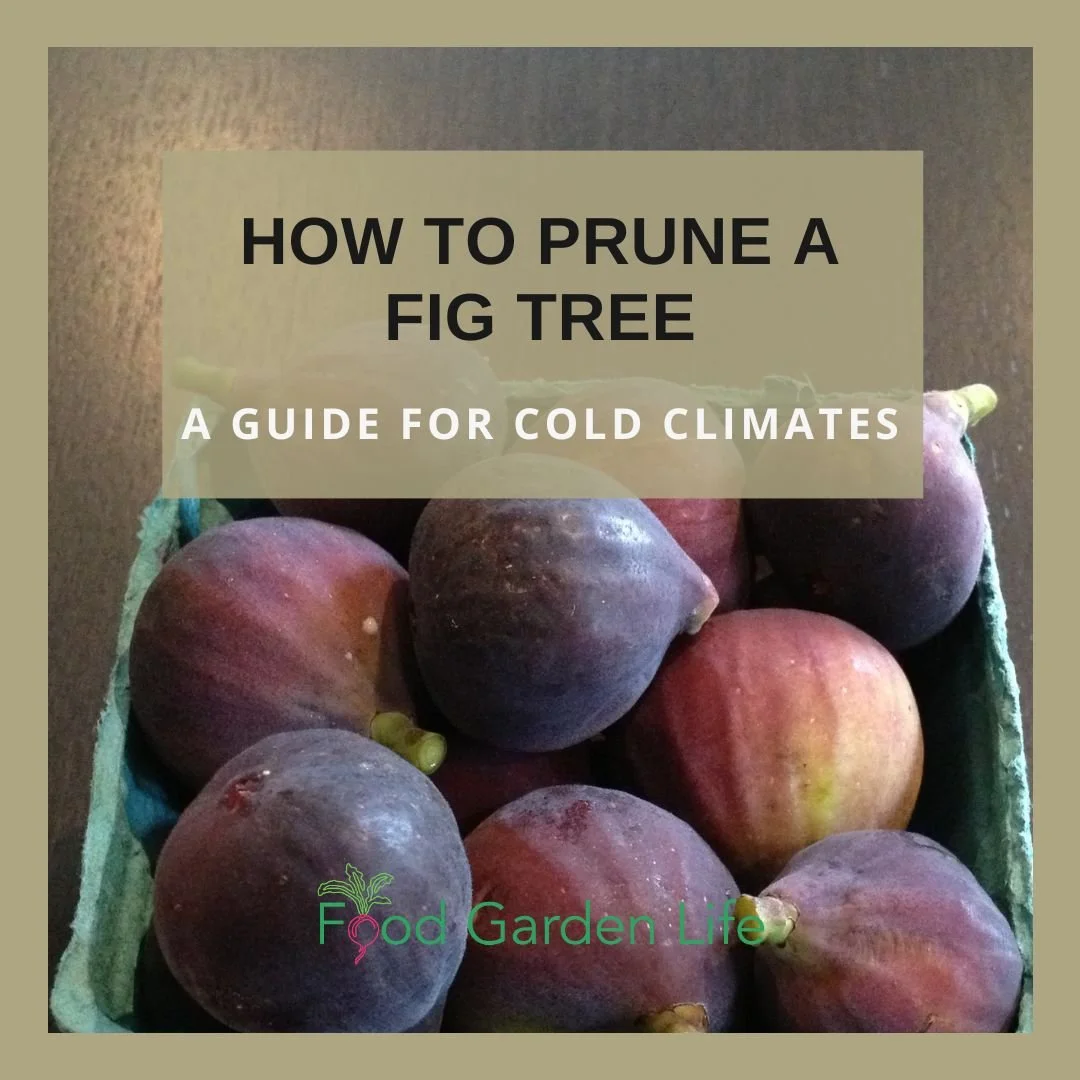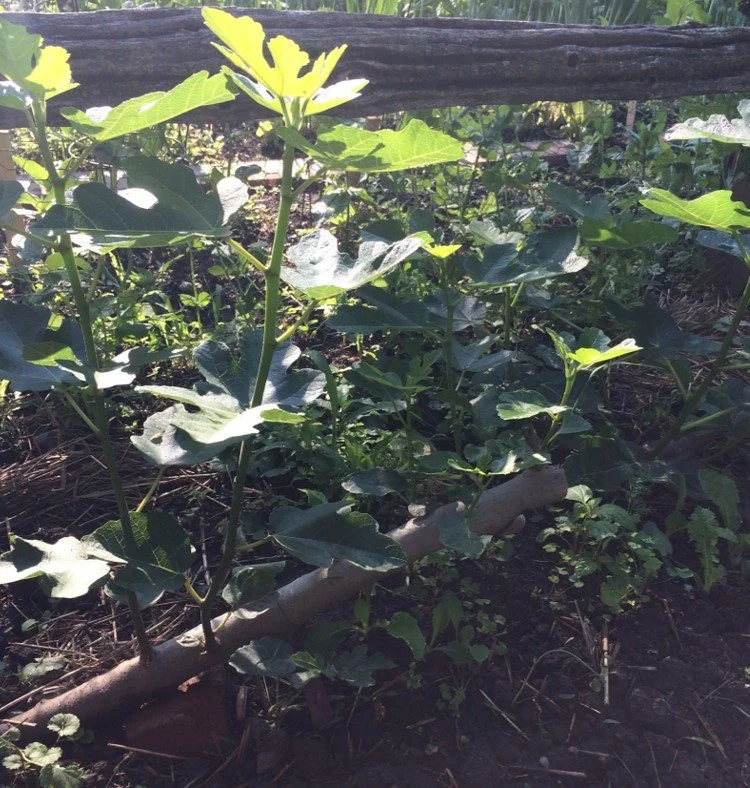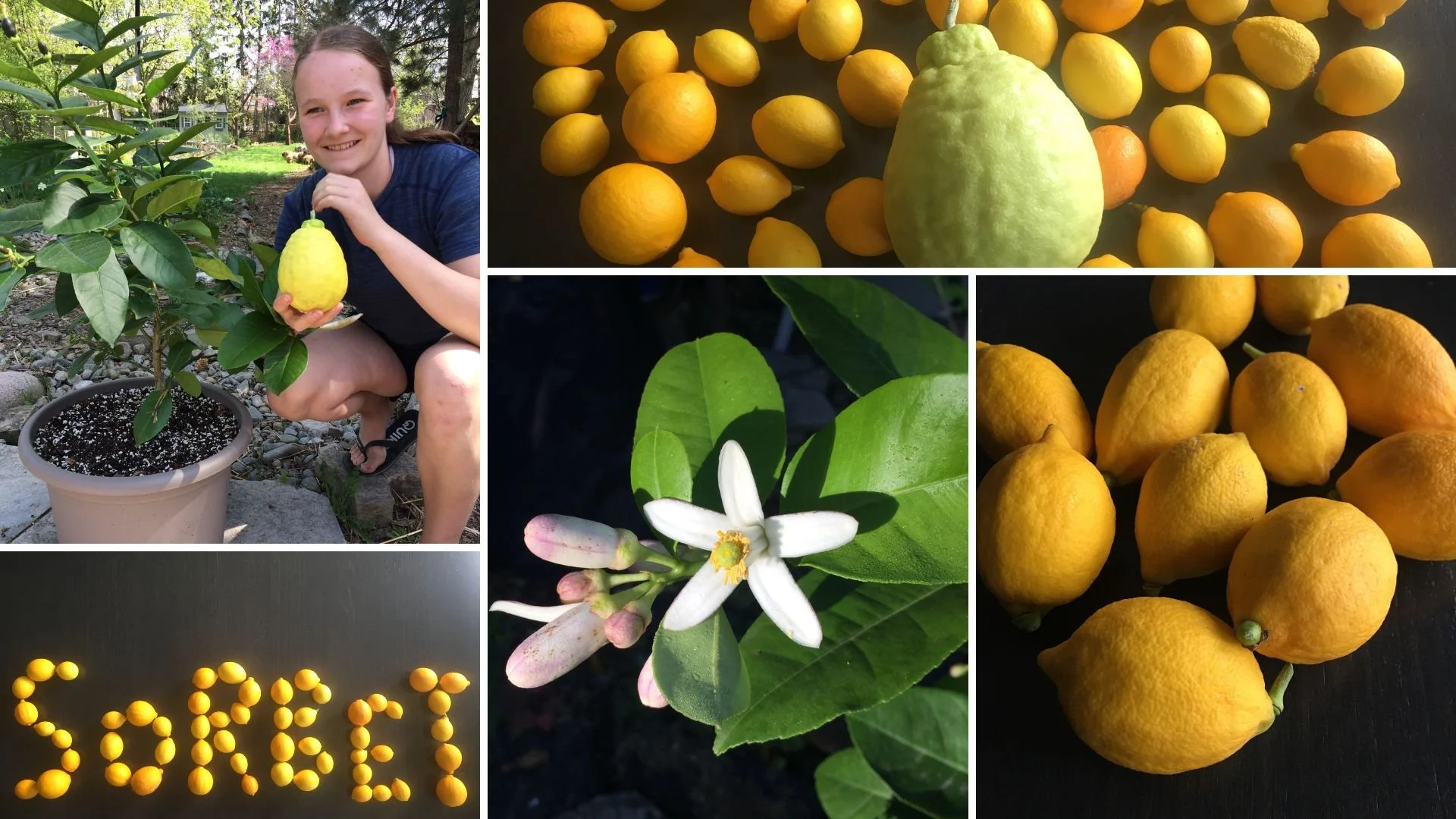By Steven Biggs
How to Prune a Fig Tree (and not Quit!)
I was really interested as one of the club members described how he clad his beloved fig tree in insulated panels every winter, making a temporary shed around it.
One of the pleasures of giving talks at garden clubs is that I get to meet lot of other plant lovers. And this guy was not only a plant lover—but a fig enthusiast too.
But then he told us that he “quit figs.”
He explained that the tree kept getting bigger…and he found it was too much work to protect it for the winter.
Please keep reading so that you don’t feel you have to quit figs. You can keep a fig tree quite compact. It’s just a matter of pruning.
Top Fig-Pruning Tip
In this article, I’ll talk about the idea of creating a permanent framework of branches on your fig plant. This framework will guide your pruning every year and make it simple. Think about your fig pruning this way, and it’s easy to prune well.
Overview of Fig Pruning
Things that Affect Fig Plant Pruning
First of all, there’s more than one approach to pruning a fig tree. There are a few things that affect how to do it, including the conditions in your garden, the variety, and the form you choose for your plant.
If that sounds overwhelming, just remember: Start by making a permanent framework of branches. After that, it’s easy.
Here are the first things to consider as we start to think about fig pruning:
I love the look of trees, and find it’s easier to fit a number of narrow potted trees into a storage space over the winter.
Tree or bush: You can prune a fig tree into a tree or bush shape. There’s no right or wrong. I love the look of trees, and find it’s easier to fit a number of narrow potted trees into a storage space over the winter. But a bush is like having “fig insurance” because you have more branches in case there’s dieback over the winter.
Uniferous or biferous: This just refers to varieties that give either one or two crops. Uniferous varieties produce only the “main crop” figs later in the season; while biferous varieties produce a breba crop early in the summer, and then a main-crop fig later. We’ll dig into pruning for both of these types below, but just keep in mind that you can prune to optimize development and ripening of breba figs, main crop figs—or a bit of both.
Pot or in-ground: If you’re growing a potted fig, consider keeping your fig short enough that you can easily fit it through a door frame for winter storage. With an in-ground plant, height is still important, but there’s more wiggle room.
Find Out How to Grow Your Own Figs
Harvest more figs this year! Grow Figs in Cold Climates Masterclass shows you how to grow a fig tree in a pot, or outside with protection. So you can harvest lots of figs!
Here are a few more things to keep in mind as you get ready to prune your figs:
Unpruned figs get bushy, with lots of spindly branches that make small fruit…this is a plant that really benefits from pruning to optimize fruit production.
Breba figs form on branches from the previous year; main-crop figs on new wood…and we’ll relate this to pruning below.
If you chop back your plant too much, main-crop figs still form on the new branches…but it might be too late for ripening in short seasons (My neighbour Joe had an in-ground fig here in Toronto that he never protected. So it died to the ground every winter, and then regrew from the root…that dieback was like a very heavy pruning, except it was done by the cold weather. Those branches that grew did eventually form figs, but they never had time to ripen in our relatively short season because the figs formed too late.)
Remove branches that cross because fig plants have a tenancy to grow into a tangle of branches.
Remember, fig trees are quite forgiving. So if you make a mistake, don’t sweat it. Better to prune and make a mistake than not to prune at all.
Pruning Basics
A lot of pruning concepts that we use with other fruit trees work with fig trees too. So let’s review some of these pruning basics:
Remove branches that cross
Space out branches to allow light and air movement within the plant
Remove suckers
Cut back to a node or a branch (do not cut half way between nodes)
Fig Pruning Basics in 3 Words
Want three words to help you visualize good fig pruning?
Up
Out
Open
You’re pruning your tree to grow upwards, outwards, and have an open structure.
Types of Pruning Cuts
When we prune our figs, there a two types of cut we can make. The plant reacts differently to them—something we can use to our advantage.
Heading Cut. A heading cut is when you shorten a branch, but leave some of it. This type of cut encourages buds on the remaining bit of branch to grow. This is how you can get branches to grow where you want them.
Thinning Cut. This is when you entirely remove a branch, cutting it right back to what it came from. This is the type of cut to make when cleaning up a tangle of branches. It’s also what I use to form single-stem specimens. Energy is redirected to the remaining branch(es).
Whatever you do, don’t shear your fig plant like a hedge. If you do that, what you’re doing is a making a lot of heading cuts – and you’ll get willy-nilly sprouting of new branches and total tangled mess of branches.
Think of Pruning in 2 Stages
Start with your formative fig pruning. This is where you shape a young, single-stemmed plant (often called a whip) to give you a permanent framework of branches.
(Your permanent framework of branches has “scaffold” limbs—the main branches. And it has secondary limbs coming off of these.)
Once you’ve created this framework, then every year you’ll do some maintenance pruning.
Developing a Shape
a.k.a. Formative Fig Pruning
Let’s get back to the idea of creating a permanent framework. Below I give pointers on how to create a permanent framework for a fig bush, tree, step-over, or fan.
When we create a bush we prune to induce branching low to the ground. Then we prune to have a permanent framework of multiple branches with an open centre.
Prune to Create a Fig Bush
When we create a bush we prune to induce branching low to the ground. Then we prune to have a permanent framework of multiple branches with an open centre. We simply using heading cuts to create a well-spaced branching form.
If you’re starting from scratch, here’s how you can do it:
Year 1
Start with a single-stem young plant.
At the end of the first season, cut back to 3-4 nodes high (this is a “header” cut that induces branch formation low down).
Year 2
New branches grow from buds on the piece of stem you left the previous fall.
At the end of year 2, keep three or four branches, cutting each of those branches back to 3-4 nodes.
Year 3
The fig bush will now grow more branches from the nodes you left on the new wood the previous fall.
At the end of year 3, cut back new growth to 3 nodes and remove spindly branches. Now you’ve made yourself a nice permanent framework of branches for a bush!
Find Out How to Grow Your Own Figs
Harvest more figs this year! Grow Figs in Cold Climates Masterclass shows you how to grow a fig tree in a pot, or outside with protection. So you can harvest lots of figs!
Prune to Create a Fig Tree
Year 1
Start with a single-stem young plant (or rooted cutting).
Pinch off side shoots and suckers.
Stake the stem if it’s flimsy. Staking and tying also helps to develop a straight trunk.
At the end of the first season, make a header cut at the height where you want the tree to branch out. (If the tree didn’t yet get to that height, continue growing it upwards in year 2 – the amount of growth it makes will depend on growing conditions.)
Year 2
One way to make a step-over fig is to plant a single-stem fig tree on an angle so that the stem is horizontal.
New branches grow from the below where you headed the single stem.
At the end of year 2, keep three or four of the new branches, cutting each of those branches back to 3-4 nodes.
Year 3
The fig tree will now grow more branches from the nodes you left on the new wood the previous fall.
At the end of year 3, cut back new growth to 3 nodes and remove spindly branches. Now you’ve made yourself a nice permanent framework for a tree!
Prune to Create a Step-Over Fig
A step-over tree is a low-growing tree grown horizontally so that you can truly just step over it. I’ve seen apple trees growing in the step-over form—and love the appearance.
There’s something else about the step-over form too…
I think the step-over concept is well suited to cold-climate fig growers as low-growing, horizontal braches are relatively easy to insulate over the winter. Depending on where you are, a blanket of straw bales or leaves could suffice.
(While you could simply rake leaves over a step-over fig, sometimes when they get wet and packed down they don’t insulate as well. The solution is to fill large plastic bags with leaves, making “leaf pillows” to insulate your step-over fig.)
Here are tips if you want to prune your fig into a step-over form (often called a cordon):
Make a header cut at a low height to encourage branches that you can train horizontally.
If you try to immediately train those branches horizontally, they probably won’t grow as quickly. So let them grow upwards initially (or at a 45°angle), and then, as they get longer, gently bend and tie them so they are horizontal.
At the end of the season, gently bend the stems to a horizontal position and pin them down.
Fig espalier in a greenhouse.
Or, if you’re in a hurry and have a single-stemmed fig tree, plant it on an angle so that the stem is horizontal.
Or…if it’s a single-stem young tree that is still very flexible, gently bend it into place (gently and slowly…I’ve snapped off plants unintentionally by trying to bend them too aggressively!)
Here’s a more detailed article about how to grow a step-over fig, a.k.a. a low cordon.
Prune to Create a Fig Fan
The idea behind a fan is that you have a fairly flat form that can go against a warm wall.
You can also prune a fig tree into a fan shape. I once saw one at a nearby garden centre and was all set to take it home with me…until I saw that it was priced at $500. I didn’t think I could explain that expenditure to my wife.
So I made my own instead.
The idea behind a fan is that you have a fairly flat form that can go against a warm wall. The wall captures and releases heat. It’s a common technique for other sorts of fruit trees in cold climates, offering protection from frost and additional heat for ripening. Ripening figs in cold climates is all about heat…
Year 1
Start with a single-stem young plant
At the end of the first season, make a header cut at a low height to encourage side branches that you can train out in a fan shape.
Year 2
Make a fan-shaped trellis that you can tie the branches to.
Thoughts on Fig Height
I’m a firm believer that cold-climate fig growers should keep plants short enough so that figs are within reach of humans – not up high in the realm of squirrels or birds.
A 20-foot-high fig tree sounds lovely, but it’s not practical in a cold climate. Pruning is your way of keeping your fig tree at a height that you can manage for picking AND overwintering. And if you do it right, you can make a very fruitful tree that suits your particular needs.
Find Out How to Grow Your Own Figs
Harvest more figs this year! Grow Figs in Cold Climates Masterclass shows you how to grow a fig tree in a pot, or outside with protection. So you can harvest lots of figs!
Maintenance Pruning for Fig Trees
Above we looked at how to make yourself a permanent framework of branches for your fig tree or bush. Now let’s look at what to do once you’ve grown your fig plant to its ultimate size. (Yes, you control the size!)
When to do Maintenance Pruning
We usually do this pruning while the tree is dormant. If I’m pruning potted figs that I store in my garage, I do this maintenance pruning when they’re dormant in the fall, before moving them indoors—so they take up less space. But for my in-ground figs growing outdoors (which I tip over and mulch for my growing conditions here in Toronto) I prune in the spring. I wait until the branches start to green up and buds swell, so that I can see if there is any winter die-back to trim off.
Prune Figs to Maximize Main-Crop Fig Production
Main-crop figs are the figs that grow on new wood from the current season.
Some varieties produce only main-crop figs. Other varieties (biferous varieties) give main-crop and breba figs. You might choose to prune a biferous fig top optimize main-crop figs (at the expense of breba figs) if you have other fig plants that give you breba figs.
Here’s an article about fig varieties for cold climates.
When pruning for main-crop figs, we are pruning to encourage new branches in the coming season.
Find Out How to Grow Your Own Lemons
Harvest more lemons this year. Grow Lemons in Cold Climates Masterclass shows you how to grow a lemon tree in a pot or outside with protection. And get lemons!
While it’s Dormant
In the late winter or early spring, while the tree is still dormant, prune growth from the previous season to encourage new branches (remember, your main-crop figs grow on new wood.)
As we think about main-crop pruning, here’s something to keep in mind: Heavy pruning can delay ripening of main crop figs.
And in cold climates, where the length of our growing season is the limiting factor to ripe figs, that delayed ripening can be a challenge.
In warm areas a common practice is to prune back growth from the previous season to the permanent framework of branches—leaving just a short nub of each branch from which new branches can grow. This causes the plant to send out a lot of new branches, and on each of those are main-crop figs.
Here’s the challenge: This type of pruning can be too drastic in a cold climate—and few, if any, main-crop figs will ripen. It depends on the season, the variety, and how soon the plant started growing in the spring.
A safer way to prune for main-crop figs is to leave more of the growth from the previous season. Cut back branches part of the way—not all of the way—to the permanent framework. (Of course, over time this will give you a taller plant, but you can prune back a few branches to the permanent framework every year.)
While it’s Growing
There’s something else you can do for main-crop figs in cold climates: Pinching the tips in the summer.
Pinching might seem strange to fig growers in warmer areas, but in a cold climate such as Toronto, I know that I’ll only get 4-6 main crop figs to ripen on a given branch. Then cold weather arrives and we run out of time. So after a branch has 5-6 little figs growing on it, I pinch out the tip. This slows down shoot growth and formation of any additional figs, and directs more energy to those 5-6 little figs we’re hoping to ripen.
Prune to Maximize Breba Fig Production
Breba figs are the figs that grow on wood from the previous year. Because of this, the pruning approach above, for main-crop figs, won’t work. It removes growth from the previous year…so would not leave any branches with breba figs!
(Remember, breba figs grow on wood from the previous season.)
So when pruning for breba fig production, we want to keep growth from the previous season—it gives us figs.
Here’s what you do:
While it’s Dormant
Leave the year-old branches coming off the end of your permanent framework—it’s what gives you breba figs in the upcoming season
Prune off 2-year-old branches coming off the end of your permanent framework. These made breba figs the previous season…and if you leave them they’ll still make breba figs, but now those breba figs will be on the new growth, up high and out of reach. So cut these off, leaving about an inch of the branch remaining on your permanent framework from which new branches can form.
While it’s Growing
Here’s an additional step for breba-producing figs in cold areas where you’re protecting the plant over the winter. A shorter plant means less work protecting (wrapping or burying)…so let’s curb upward growth!
In spring and early summer, you’ll clearly see where the breba figs are, and, beyond that, the new growth that would eventually make main-crop figs. Pinch out the tip of that new growth to curtail the upwards growth of the plant.
Here’s more about winter protection for figs growing in cold climates.
Fig Pruning FAQ
I’m not starting with a young tree to grow into a nice framework. It’s already branched. What should I do?
There are probably some branches worth keeping. But if you’re new to pruning, mark branches before you start cutting. Put tape on the branches you want to remove before starting to prune. This will help you to visualize what the end result will look like.
Remember, with a heading cut you can make your fig grow branches where you want them.
What if I don’t prune one year?
If you miss a year, you certainly won’t hurt your fig tree. It will just get taller! Just be prepared to prune it back to your permanent framework the following year. And a heavier pruning might give you a bit less fruit production for a year—but it certainly won’t hurt the plant.
What if I have a mature bush that’s not well pruned?
Pick a four or five well-spaced branches to keep, and then tidy up the rest.
How small can I keep my fig tree?
Many new fig growers are reluctant to prune. It’s probably a combination of things: Pride at seeing the growth on the fig plants; and concern, too, that if they prune too much they might harm the plant. So please remember this: Like bonsai, the gardener determines the ultimate plant size. You’re the boss!
What can I do with the branches I pruned off of my fig plant?
This is the fun part! Root them.
I have an article about rooting fig cuttings here.
Another idea: If you like to make smoked food, fig wood gives a taste that’s very different from other fruit woods. Try it!
As well as using fig branches for a tasty smoke, you can cook with fig leaves. Find out how to use fig leaves in the kitchen.
What if I want to prune to get a mix of breba and main-crop figs?
You’ll take ideas from both of the pruning approaches above, so that you have a mix of branch tips from the previous season to give you breba figs, and you’re encouraging new branches that give you main crop figs. I’m working on that article next!
Want More Fig Information?
Find Out How to Grow Your Own Figs
Harvest more figs this year! Grow Figs in Cold Climates Masterclass shows you how to grow a fig tree in a pot, or outside with protection. So you can harvest lots of figs!













